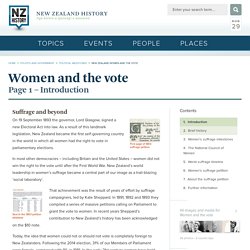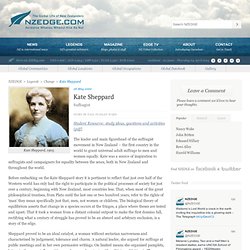

Kate Sheppard, 1847-1934. New Zealand women and the vote. On 19 September 1893 the governor, Lord Glasgow, signed a new Electoral Act into law.

As a result of this landmark legislation, New Zealand became the first self-governing country in the world in which all women had the right to vote in parliamentary elections. In most other democracies – including Britain and the United States – women did not win the right to the vote until after the First World War. New Zealand’s world leadership in women’s suffrage became a central part of our image as a trail-blazing ‘social laboratory’. That achievement was the result of years of effort by suffrage campaigners, led by Kate Sheppard. In 1891, 1892 and 1893 they compiled a series of massive petitions calling on Parliament to grant the vote to women. Today, the idea that women could not or should not vote is completely foreign to New Zealanders. Women win the Vote - NZ 1893. Sheppard, Katherine Wilson – Biography. Page 1 Kate Sheppard Kate Sheppard, about 1905 National Council of Women, Christchurch, 1896 Sheppard, Katherine Wilson Suffragist, social reformer, writer This biography was written by Tessa K.

Catherine Wilson Malcolm was born in Liverpool, Lancashire, England, probably on 10 March 1847, the daughter of Scots parents Jemima Crawford Souter and her husband, Andrew Wilson Malcolm, a clerk. Her father died in 1862, and in 1868 her mother brought Katherine and her two brothers and a sister as saloon passengers to New Zealand; they arrived on the Matoaka at Lyttelton in February 1869. In 1885 Mary Leavitt, an evangelist delegate from the Woman's Christian Temperance Union of the United States of America, commenced her mission in New Zealand and Kate Sheppard became a founding member of the New Zealand Women's Christian Temperance Union.
The franchise department of the WCTU took the first of three major petitions to Parliament in 1891. Many of these articles were written by Sheppard. Legends — Kate Sheppard, Suffragette — Change. Student Resource: study ideas, questions and activities (pdf) The leader and main figurehead of the suffragist movement in New Zealand – the first country in the world to grant universal adult suffrage to men and women equally.

Kate was a source of inspiration to suffragists and campaigners for equality between the sexes, both in New Zealand and throughout the world. Before embarking on the Kate Sheppard story it is pertinent to reflect that just over half of the Western world has only had the right to participate in the political processes of society for just over a century, beginning with New Zealand, most countries less. That, when most of the great philosophical treatises, from Plato until the last one or two hundred years, refer to the rights of ‘man’ they mean specifically just that, men, not women or children. The biological theory of equilibrium asserts that change in a species occurs at the fringes, a place where theses are tested and upset. Early Edification Success … Eventually. Kate Sheppard. Kate Sheppard was the leading light of the New Zealand women’s suffrage movement.

In recent years her contribution to New Zealand’s identity has been acknowledged on the $10 note and a commemorative stamp. Born in Liverpool in 1847, Kate Malcolm migrated to Christchurch in her early twenties and in 1871 married merchant Walter Sheppard. In 1885 she joined the new WCTU, which advocated women’s suffrage as a means to fight for liquor prohibition. For Kate Sheppard, suffrage quickly became an end in itself. Speaking for a new generation, she argued, ‘We are tired of having a “sphere” doled out to us, and of being told that anything outside that sphere is “unwomanly”.’ Sheppard travelled the country, writing to newspapers, holding public meetings and lobbying members of Parliament.
In 1893 Kate Sheppard and her fellow suffragists gathered the signatures of nearly 32,000 women to demonstrate the groundswell of support for their cause. By Emma Brewerton.